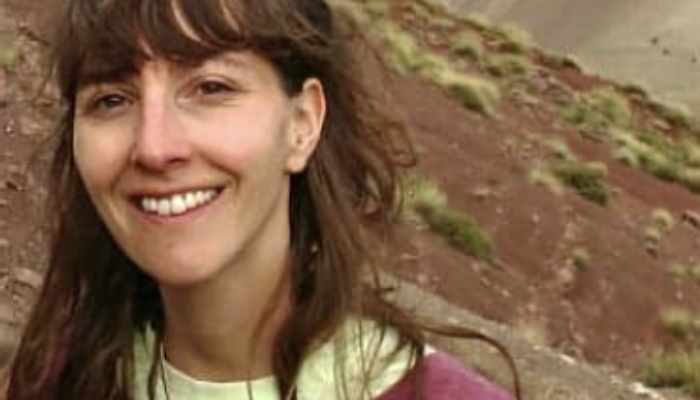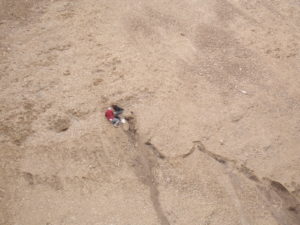
Hello Alicia, thank you for agreeing to this interview! Before we dig in, could you tell us a little about yourself and your research?
Hi Simon, many thanks for giving the nice opportunity to present my research activities. I am Alicia Fantasia and I was born in Switzerland.
I have always been passionate about the Earth system, I am sensitive to current climate change issues, and … fascinated by dinosaurs. Earth history was punctuated by several extreme climatic and environmental perturbations and there is certainly knowledge to be gained from these events. That’s probably motivated my career orientation to become a researcher curious to reconstruct the environmental and climatic conditions in the geological record. Indeed, my research focusses on geological time intervals, in particular the Jurassic, marked by extreme environmental and climate changes. The overarching goal of my work is to understand the causes, the consequences, and the environmental feedback loops associated with these events by studying sedimentary rocks to decode the complex interplay between climate and biogeochemical cycles.
I have an interdisciplinary approach, which combines fieldwork sessions with mineralogical and geochemical analyses. After my master’s degree and PhD thesis in Sedimentology at the University of Lausanne in Switzerland, I did a postdoc at Aarhus University in Denmark, and I am currently a postdoctoral research fellow (Marie Skłodowska-Curie Actions) at the Université de Lyon in France. The focus of my project is to understand the response of Earth system to past hyperthermal events and determine the natural feedback mechanisms that enable the recovery and return to pre-crisis conditions. To answer key and yet debated questions about the Earth’s system dynamics and recovery, I am using novel and cutting-edge analytical tools such as lithium and helium isotopes.
Some 183 million years ago the Earth’s oceans were depleted of oxygen, resulting in a mass extinction of marine life. As a researcher studying such environmental changes, your work often seeks to relate such events to contemporary change. Could you tell us more how studying ancient events can help us understand current processes?
Climate change is one of the most pressing global challenges for the sustainable development of our societies, and our ability to tackle this challenge requires advanced understanding of its impact on the atmosphere, continents, and oceans. The coincidence between increase in greenhouse gases and the temperature suggest that anthropogenic emissions of greenhouse gases, such as CO2, have direct impact on the climate system. There is alarming evidence that current global warming has already affected physical and biological systems. Examples, amongst others, are the bleaching of the corals, the Arctic ice decline, the widespread decline of oxygen in aquatic systems linked to eutrophication, the sixth mass extinction of wildlife, etc.
Past episodes of global warming preserved in the geological record represent a fundamental opportunity for geologists to extract tangible constraints on the interactions between climate and biogeochemical cycles and understand how the system can return to pre-crisis conditions or steady state. In particular, the Toarcian Oceanic Anoxic Event (T-OAE, about 183 Ma, Early Jurassic) is of major interest since it was one of the most extreme hyperthermal events in Earth history, associated with major perturbation of the carbon cycle, changes in the ocean chemistry and acidification, marine anoxia, and biotic turnovers in marine and terrestrial ecosystems. The T-OAE is hence probably one of the most suitable yardsticks to current climate change. Although the kinetics is likely different between the T-OAE processes and those observed today, there is certainly knowledge to be gained to find mitigation and adaptation solutions to current climate change.
Profound environmental events can considerably change the trajectory of how environmental systems develop, from influencing geochemistry to shifting evolutionary trends. Despite the broad impact of these events, putting together a clear image of them can be difficult, nonetheless. How do scientists such as yourself piece together useful and clear ideas of past environmental changes?
Indeed, I reckon that it is not always easy, especially when you are studying deep time records. It is easier to understand modern systems and environmental changes because you have the processes happening LIVE. To tackle eventual uncertainties, I am using a multiproxy approach. This means that I combine independent proxies to unravel the role of local processes on global trends and hence get robust and clear interpretations of the geological processes and mechanisms involved in the environmental perturbation.
You’re also the Early Career Scientist Representative for the Stratigraphy, Sedimentology and Palaeontology (SSP) Division. Could you tell us more about the Division’s activities and how you are involved?
As Early Career Scientist Representative (ECS) for the Stratigraphy, Sedimentology and Palaeontology (SSP) Division, I represent the early career researchers within our division and make the link between them and the EGU. All Divisions have representatives, and we have regular meetings to take actions and discuss the activities we can do to support young researchers in their career and maintain communication with the broader EGU structure. The overarching goal is to enable fruitful scientific discussion between the early career scientists and the other members of the scientific community. We also organize events during the General Assembly, such as networking events for our SSP Division and for the ECS, and have outreach roles by advertising any news on social media.
Finally, what’s the future looking like for yourself?
Well, for the near future it is to continue with my Marie Curie project, which will end in February 2023. The dataset already acquired until now is really exciting and promising to better understand how the Earth system can recover after extreme climatic events! I want to continue in academia and my medium to long term research ambitions are to obtain a professorship to conduct independent and innovative projects with my own team and develop a sedimentary geochemistry laboratory at the forefront of current and future research needs in the domain.





